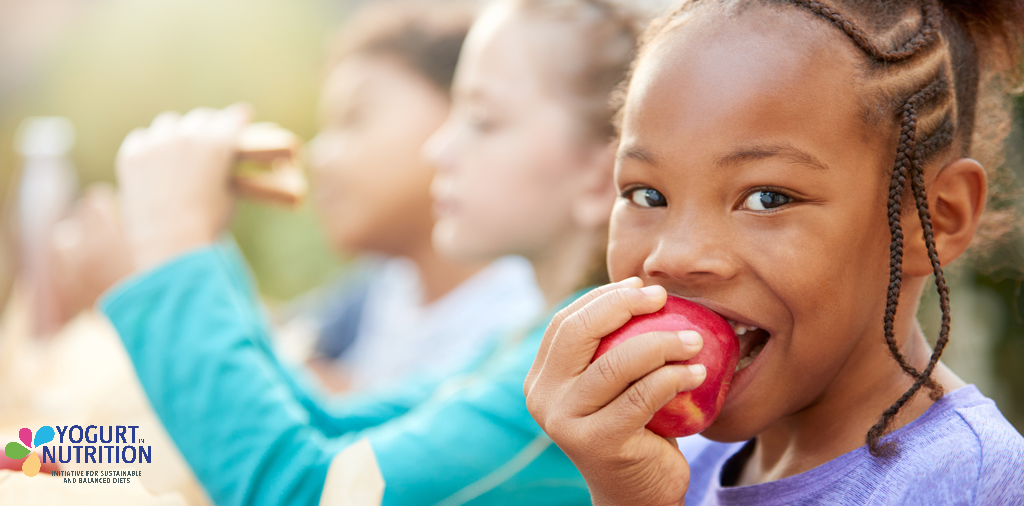What’s the best gift you could give a child? Some would argue it’s the promise of a long and healthy life on a planet that’s also healthy and robust.
The best way to achieve this, scientists say, is for parents and schools to put kids on track for healthy eating practices from an early age to protect them from obesity and its associated risks throughout their lives (1). And the good news is that it doesn’t have to cost the Earth.
Early years offer a great chance to shape healthy sustainable eating
Dietary choices in childhood not only are sustained into adulthood but also have a long-lasting effect on future health. Children who struggle from weight issues may keep struggling into adulthood and are at risk of suffering illnesses such as diabetes and heart disease. That is why establishing healthy nutrition and lifestyles right from early childhood may be key in obesity prevention at individual and population level. It could also support sustainability in the economy and environment.
Family and school are the main childhood influencers
Parents, but also guardians and caregivers, including nurseries and day-care services, have the earliest influence in encouraging children to adopt life-long healthy eating habits. They do this through the foods they offer to the child – both in terms of quality and quantity, and in the variety of choices (2).
Children love what they know, and introducing a wide variety of foods and flavours in the first 3 years of life is the perfect time to let the child explore and get used to different tastes.
Once kids reach school age, they’re likely to eat one main meal a day there, and so school-run intervention and education programmes to optimise diets have great potential for raising children’s awareness of health and nutrition and empowering them to make informed and healthy food choices.
‘Family, school, and community are the crucial environments where educational interventions can be instituted.‘ – Mazzocchi A, et al. 2022.
Health of the planet: a major factor for menu choices
Nowadays, the planning of school meals should take into account not only meeting the nutritional needs of children according to age but also the environmental impact of its components. Scientists recommend a switch to flexitarian diets, plant-based diets with some animal sourced products, starting in early life and ensuring the diet contains all the nutrients required.
Sustainability practices that may be adopted in schools include establishing school vegetable gardens, buying local foods, and reducing food waste through recycling and composting. These measures can involve the children’s participation throughout and, with education programmes, can help them learn about the impact of their dietary choices.
It’s not just taste that matters
For a successful strategy, meals need to be more than just tasty – they must also be acceptable for the children’s cultures and religions while being affordable for the providers.
Studies show that it is possible to design nutritional diets that are both affordable and environmentally sustainable. One modelling study in Spain used combinations of 20 starters, 20 main dishes, and 7 desserts, to carry out a 20-day planning period with the aim of meeting nutrient requirements and reducing both the carbon footprint and the lunch budget. The study found that optimised school menus could shrink the carbon footprint by 13-24% and cut the costs by 10-15% while maintaining adequate nutritional content (3).
An intervention study in Sweden looked at the effects of a 4-week lunch menu that was optimised for greenhouse gas emissions, nutritional adequacy and affordability. The optimised strategy resulted in a food list that had 40% less greenhouse gas emissions and was 11% cheaper than the original menu, while meeting all the nutrient recommendations for school meals (4).
‘School meals, in line with dietary recommendations, represent a way to transmit food routines, contributing significantly to overall eating behaviours.’ – Mazzocchi A, et al. 2022.
Childhood obesity: a growing global concern
Childhood overweight and obesity are a growing public health crisis worldwide (5):
- By 2020, globally 39 million children under 5 years of age were overweight or obese. On top of that, the COVID-19 pandemic has led to economic, food, education and health systems disruptions that are likely to have added to the problems of malnutrition (under and over) globally. Consumption of comfort food (high in fat, sugar and salt) increased during the pandemic and the more sedentary lifestyle may have contributed to the rise in obesity.
- Healthy dietary patterns established by the age of 3 years tend to be maintained throughout childhood. These early years are particularly important because during adolescence, other factors may influence dietary choices, such as food marketing, peer pressure and body image perception. Adopting a healthy diet from childhood and maintaining it into adolescence are key to a healthy dietary pattern in adulthood, supporting health throughout life



